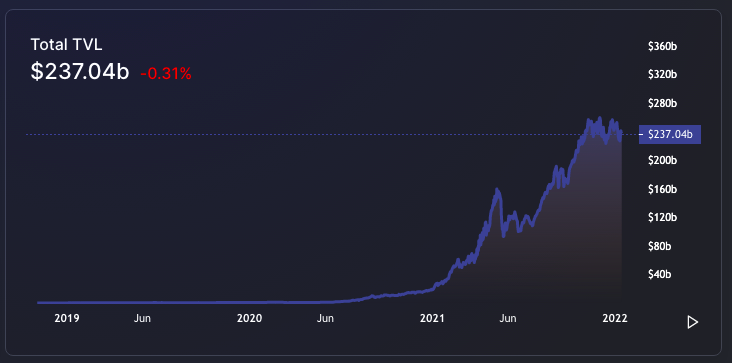The application of blockchain technology in the world of finance has created a new landscape called DeFi or decentralized finance. DeFi has manifested an astonishing growth in the year 2021 and it is still burgeoning. It has unleashed a wave of innovation.
What exactly is DeFi?
There is no standard definition for Decentralized Finance. Some say it is an alternative financial infrastructure, some say it is an umbrella term for peer-to-peer financial systems, some say it is a competitive marketplace of decentralized financial applications, and so on.
Decentralized Finance is an ecosystem of financial applications and protocols that runs on blockchain technology. Blockchain technology is inherently decentralized in nature. DeFi financial applications leverage this aspect and run without relying on intermediaries like banks, brokers or exchanges. Moreover, the backbone of all DeFi protocols and applications is smart contracts.
What problems does DeFi solve?
The biggest and the fundamental problem that DeFi solves is the removal of intermediaries in the financial system. Harvey et al. in their book Defi and the Future of Finance describe that DeFi solves five key problems of the current financial system: centralized control, limited access, inefficiency, lack of interoperability, and opacity.
Harvey et al. in their book Defi and the Future of Finance describe that DeFi solves five key problems of the current financial system: centralized control, limited access, inefficiency, lack of interoperability, and opacity.
The DeFi Market:
DeFi has manifested tremendous growth in the year of 2021. As of January 15, 2022, the total value locked in the DeFi space was approx $237 billion, growing by a staggering 1,266% from the January 1, 2021 figure of $18.71 billion.

Figure 1: Total value locked (TVL) in DeFi as of Jan 15, 2022 (Source DeFi Llama)
How can DeFi solve your problems?
DeFi solves the problem of lack of transparency in the traditional finance system through the open and contractual nature of agreements. Smart contracts helps to encode the agreements. Anyone can read the smart contracts codes thereby ensuring transparency. Moreover, all transactions are publicly visible.
Traditional financial system is trust based and dependent on centralized institutions. DeFi replaces some of these trust requirements with smart contracts. The decentralized blockchain network stores the smart contracts.
Before we delve into each problem, let’s look at the different layers of the DeFi stack.

Figure 2: DeFi Stack
The settlement layer (Layer 1) consists of the native protocol of the blockchain network (e.g., ETH, BTC, MATIC). These native tokens are specific to their blockchain network, i.e, ETH is on Ethereum network, BTC is on Bitcoin network, and so on.
The asset layer (Layer 2) consists of all the assets issued on top of the settlement layer. These assets are usually referred to as tokens (e.g., ERC-20 based DAI token in Ethereum). Developing smart contracts that follow EIP standards like ERC-20, ERC721, ERC1155 helps to create tokens.
The protocol layer (Layer 3) contains the smart contract-based protocol implementation for different use cases such as decentralized exchanges (DEX), lending, derivatives, on-chain asset management, and so forth.
The application layer (Layer 4) consists of end-user applications which are accessible via web browsers or mobile apps.
Layer 5 is the aggregation layer that combines several protocols and applications and provides services like rate comparison, trading strategies, and so forth (e.g., 1inch, Zapper, Zerion).
DeFi solves the problem of limited access by allowing the creation of an open and accessible financial system. It enables direct access to financial services for the globally unbanked population. As a result, it allows access to all users irrespective of their wealth or geographic location.
DeFi in the current world:
Trading today is extremely centralized in the traditional finance world. Five exchanges control 50% of the volume of all stocks. In a traditional exchange like the New York Stock Exchange buyers and sellers offer up different prices until they come to an agreement on a sale price. Only a small subset of the traditional finance world has access to the full order book of prices, limiting price discovery for everyday users. However, there is a limit on the liquidity for certain securities. DeFi solves these problems with an innovation called automated market makers (AMM).
Decentralized Exchanges use an automated market maker (AMM) for automated trading. AMMs is essentially an exchange which helps to swap one cryptocurrency for another. The liquidity pool maintains a particular exchange rate, for example 10 ETH to 1 BTC. This is a pool with a variable exchange rate between two currencies. The AMM facilitates a price for transactions based on the supply, demand and liquidity in a pool. The investors in the pool put money into it to earn a yield. Some of the popular decentralized exchanges are Curve Finance, Uniswap, PancakeSwap, and SushiSwap.
Traditional finance institutions tend to work in silos and maintain their own ledgers. Hence one financial service may not be interoperable with another. DeFi is built on public blockchains and open standards. This allows for interoperability across different decentralized apps (or dapps). However, there is a limit on the interoperability to the same blockchain network. As a result, there are lots of initiatives in progress that focus on enabling cross-chain communication across different blockchain networks.
Final Thoughts:
FinTech has been trending over the past few years. Many FinTech startups have been harnessing innovation and using technology to improve the delivery of financial services. Fintech companies use technology to create better financial services to customers and other businesses. They include big data, AI/ML, automated CRM, robo advising, personal finance, insuretech, payments, lending platforms, and so on. However, one main difference between FinTech and DeFi is that most of the FinTech solutions are centralized; however all DeFi platforms are decentralized.
Defi not only addresses the drawbacks of the centralized finance systems but also has paved the way to many innovative financial instruments such as atomic swaps, autonomous liquidity pools, decentralized stablecoins, flash loans, among others. In short, DeFi has a lot of potential and can play a pivotal role in the future of finance.
Like other businesses, if you too are looking to develop IT Solutions in Financial Services industry, Mindfire Solutions can be your partner of choice. We have gained significant experience over the years working with Fintech Companies. We have a team of highly skilled and certified software professionals, who have developed many custom solutions for our global clients over the years.
Here are a few interesting projects we have done. Click here to know more:
Case study on e-Wallet mobile application.
